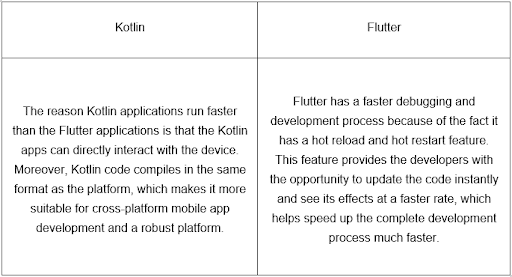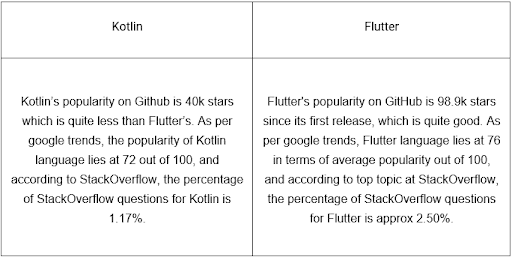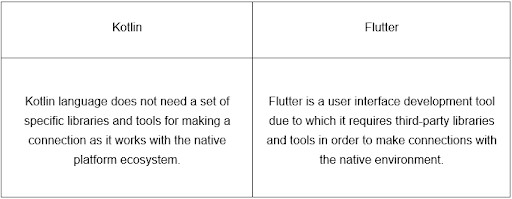Mobile apps have become an integral part of our lives. Everything is available with just a few taps, from booking an air ticket or hotel to ordering food, shopping for apparel, ordering groceries, and paying utility bills. And now, two major languages and frameworks dominate the development of mobile applications. Kotlin and Flutter. Whereas hotlines is a programming language and Flutter is a system.
Before cross-platform development, Flutter and React Native was the go-to programming solutions, and developers highly used these languages. However, today Kotlin has also become very popular and has managed to enter the competition. So, the debate started over who will rule the market and which will be more demanding for application development. Let’s go into the depth of it to understand the difference between them, then we can think about which one we prefer.
What is Flutter
Flutter is a cross-platform UI toolkit to build fast, beautiful, natively compiled applications with Dart programming languages for mobile, web, and desktop. This makes the software with a single programming language and coding. It’s open-source and free. First developed by Google in May 2017, Google now administers an ECMA standard. It is an increasingly popular technology that provides excellent native experiences. Google introduced it as an SDK for developing modern iOS and Android mobile apps. If we are using Android Studio, it comes with built-in Java and Goal C and Swift on iOS.
What is Kotlin
Kotlin is an open-source programming language, a cross-platform. This can be found using Java, a dynamically typed JVM language. Also, we can use it for Android apps, server apps, and many more. Technology emerges as the most successful. JetBrains developed it and launched a small project in 2010. In February 2016, Kotlin’s first official release was made. The Apache 2.0 license has been created. Kotlin has a specific “Kotlin Multiplatform” function: JVM bytecode, LLVM code compatible, or JavaScript. Kotlin has an unlimited application range.
Kotlin vs. Flutter Comparison
Performance
Popularity
Integration of Third-Party Libraries
The Biggest Advantage
Both solutions come with their strongest advantage, and now we will break them down to better understand which solution will be the best for developing mobile application software.
Advantages of Kotlin
Null safety: Null safety is one of the most innovative features of the Kotlin language. This feature eliminates the risk of null pointer exceptions by differentiating between nullable and non-nullable references, and Kotlin doesn’t compile the code which tries to return null.
Robust performance: In Kotlin language, the code you write is compiled in the same format as the platform it is planned; this feature provides the performance to the native app development, making Kotlin language a robust platform.
Easy to learn: Kotlin language is inspired by other languages like Java, C#, etc. The syntax of the Kotlin language is also quite similar and less strict to Java. Users who already know Java find the Kotlin language very familiar and easy to understand. Also, because of its interoperable nature with Java, both languages can co-exist, making things easier for developers.
Concise and easy to maintain: In Kotlin language, you don’t have to write the entire code; unlike Java, you can write the same code with fewer lines.
Also, Koltin has a single codebase that makes it a stable language for development, and you can easily detect errors before running the code.
Advantages of Flutter
Hot reload: This feature allows you to see the changes that you have created, like fixing bugs, building the user interface, etc., and those changes are then reflected instantly. It helps you to write code faster and with ease.
Less development cost: In Flutter, you can use the same code because of native app development, which allows you to reuse most parts of the code. This helps cut the development time and resources, which helps reduce the budget by up to 30-40%.
Widgets: Flutter SDK comes with numerous widgets that offer many capabilities, make the app attractive, and are also used for displaying, designing, and handling interaction.
MVP and Prototype development: MVP (minimum viable product) is a simpler version of the app or software that solves the problem statement. It helps to give the true potential of the idea. It helps attract the users’ interest in the product you are planning to launch. Flutter is a cross-platform development tool, so minimum time and resources are needed and can be assessed if the idea is good or not.
Conclusion
In this article on Kotlin vs. Flutter, you learned many things, including what exactly is Kotlin and Flutter. Then, you compared them in terms of performance, popularity, and integration of third-party libraries. Then, you also learned about the advantages of Kotlin language and Flutter.
If you are still looking for the best way to develop a mobile app, the answer will come with another question: what are your requirement is. Flutter is the answer if you are low on budget and aim for a faster development process. But if you are looking for better-integrated libraries, easier to maintain and have great capabilities to cross platforming software, Kotlin is the best answer you can get.
As an Android development company in Indonesia, We have been trusted to serve more than 100 international startups, in supporting the sustainability of their Android app projects by sending our reliable Android app developers. Let’s discuss this with us today!






